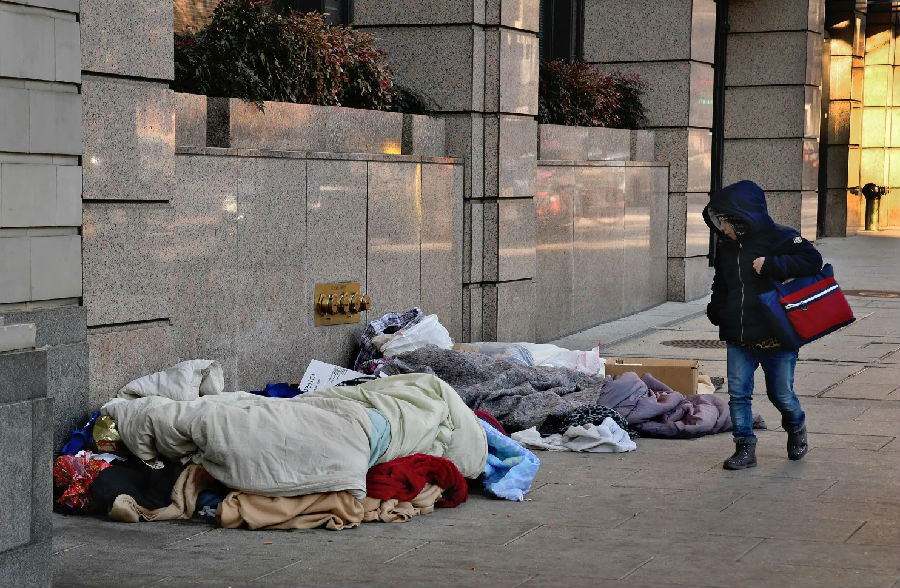An App Tries to Find Beds for The Homeless
為無家可歸者尋找安睡之地的應(yīng)用
The epicenter of innovation is turning to software to help the most vulnerable get off the streets
創(chuàng)新之地美國正在研發(fā)軟件,幫助無家可歸者告別露宿街頭的生活。
On paper, it looks as if San Francisco shouldn't have a homelessness problem. There are as many permanent housing beds as people who need them.
按理說,舊金山不應(yīng)該再有露宿街頭的人了,需要安睡之地的人都該有地方休憩了。
The city spends hundreds of millions of dollars to help get people off the streets, and last year voters approved a measure to raise $300 million annually to tackle the issue by taxing local companies.
舊金山花費(fèi)數(shù)億美元幫助無家可歸者告別露宿街頭的生活,去年選民通過了一項(xiàng)措施,每年籌集3億美元,通過向當(dāng)?shù)毓菊鞫悂斫鉀Q這個(gè)問題。
Yet there are about 7,500 homeless in the city because of soaring rents and the difficulty of treating substance abuse, mental illness, and other health concerns.
然而,由于房租飛漲以及難以治療藥物濫用、精神疾病和其他健康問題,該市大約有7500名無家可歸者。
Now the world capital of innovation and Big Data is betting that streamlined information is the answer.
現(xiàn)在,全球創(chuàng)新及大數(shù)據(jù)之都的管理者們確信,精簡化信息才是解決問題之所在。
City officials have spent the past two years building a digital program called ONE System (for online navigation and entry) that can track and monitor every homeless person in San Francisco.
舊金山市官員花費(fèi)兩年時(shí)間建立了一個(gè)稱為“在線導(dǎo)航入住系統(tǒng)(ONE System)”的數(shù)字化程序,可以追蹤和監(jiān)控該市的流浪漢們。
The idea is simple: Collect and sort information associated with the homeless to more effectively assess risk factors, determine those most in need, and get those people into available shelters and transitional housing.
其想法很簡單:收集與無家可歸者相關(guān)的信息,并進(jìn)行分類,以便更有效地評(píng)估風(fēng)險(xiǎn)因素,確定最需要住所的人,讓他們住進(jìn)庇護(hù)所和過渡性住房。

But the reality is more complicated. Five months after its introduction, ONE System has helped get only 70 people off the streets as it contends with the same challenges that have plagued past efforts—as well as new ones,
但現(xiàn)實(shí)情況更為復(fù)雜。在此程序推出五個(gè)月后,它只幫助過70個(gè)流浪漢找到住所,因?yàn)樵摮绦蛎媾R著一些挑戰(zhàn),而這些挑戰(zhàn)曾困擾舊金山市過去為解決該問題所做的各種努力,未來要進(jìn)行的新嘗試同樣也要經(jīng)受這些挑戰(zhàn)的考驗(yàn)。
including persuading the city's most at-risk population to sign on to a program with echoes of Big Brother.
其中包括說服城市最高危人群簽署與“老大哥”項(xiàng)目相呼應(yīng)的計(jì)劃。
Designed by Nevada startup BitFocus Inc., ONE System collects data from 15 city and state agencies.
由內(nèi)華達(dá)州創(chuàng)業(yè)公司BitFocus Inc.設(shè)計(jì)的ONE System,從15個(gè)城市和州機(jī)構(gòu)收集數(shù)據(jù)。
Homeless participants are asked 17 questions that can help evaluate their individual situation, including time spent on the street, health, and vulnerability.
參與調(diào)查的無家可歸者回答17個(gè)問題,這些問題幫助評(píng)估他們的個(gè)人情況,包括在街頭流浪的時(shí)間、健康狀況和高危性。
That information—along with a record of the places in the city that a person frequents—is used to create a database that acts as a digital profile,
這些信息連同流浪者經(jīng)常出現(xiàn)的城市地點(diǎn)記錄,會(huì)被用來創(chuàng)建一個(gè)數(shù)據(jù)庫,作為數(shù)字檔案。
allowing caseworkers to better coordinate health, housing, and histories to allocate resources instead of sifting through mountains of paperwork.
使社工更好地協(xié)調(diào)有關(guān)健康、住房情況和個(gè)人經(jīng)歷等信息后分配資源,而不用在成山的文件資料中篩選。
"We're trying to build what I think of as an air traffic control system," says Jeff Kositsky, the director of the city's department of homelessness and supportive housing.
舊金山市無家可歸和支持性住房部門主管杰夫·科斯基表示:“我們正在努力建立一種空中交通管制系統(tǒng)。”












